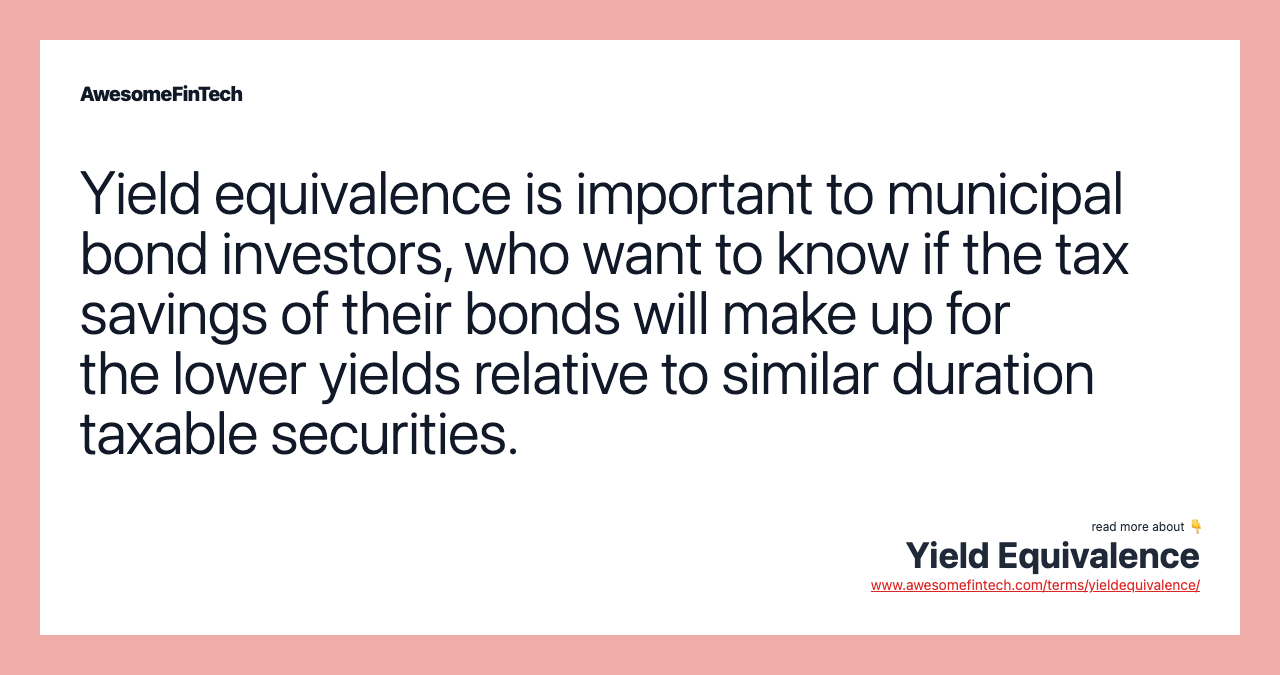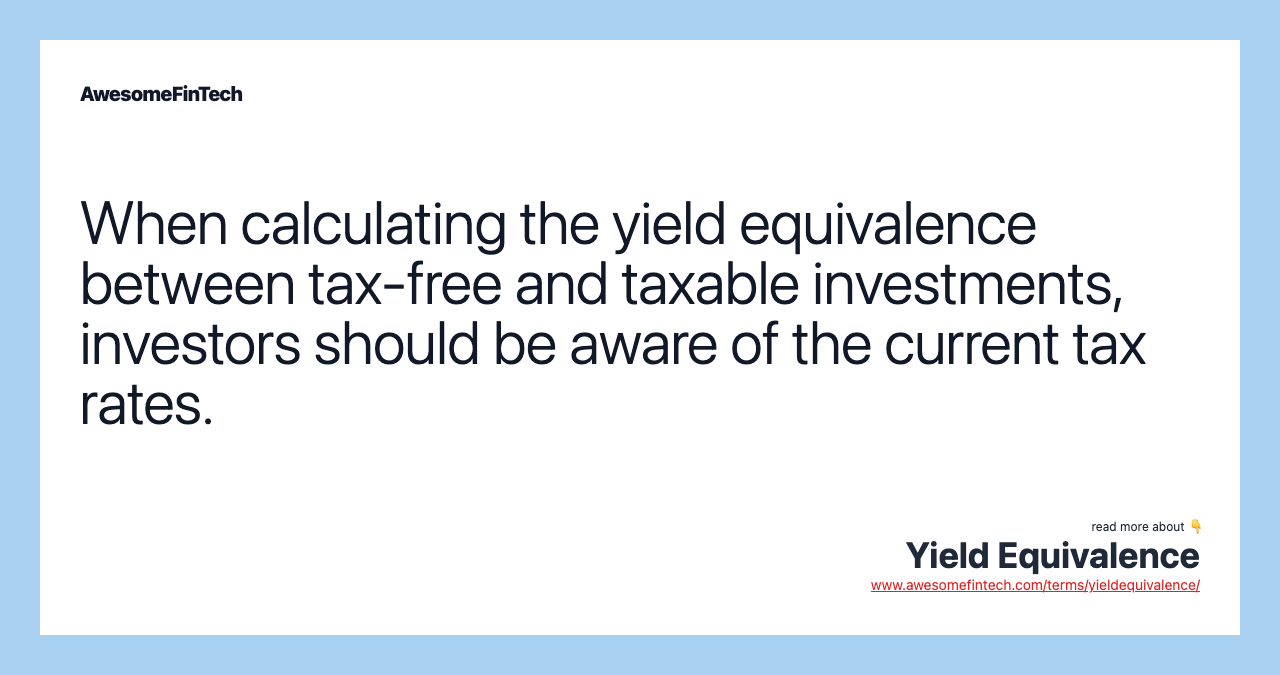Yield Equivalence
Yield equivalence is the interest rate on a taxable security that would generate a return equivalent to the return of a tax-exempt security, and vice versa. Yield equivalence can be calculated using the following equations: Taxable Yield Equivalence \= Tax-Exempt Yield 1 − Tax Rate \\begin{aligned} &\\text{Taxable Yield Equivalence} = \\frac { \\text{Tax-Exempt Yield} }{ 1 - \\text{Tax Rate} } \\\\ \\end{aligned} Taxable Yield Equivalence\=1−Tax RateTax-Exempt Yield Tax-Exempt Yield Equivalence \= Taxable Yield × ( 1 − Tax Rate ) \\begin{aligned} \\text{Tax-Exempt Yield Equivalence} =& \\ \\text{Taxable Yield} \\ \\times \\\\ &( 1 - \\text{Tax Rate} ) \\\\ \\end{aligned} Tax-Exempt Yield Equivalence\= Taxable Yield ×(1−Tax Rate) So, if your taxable return is 6% and your rate of taxation is 24%, you need a 4.6% return on a tax-exempt security to match the after-tax return on a taxable security. To calculate the yield equivalence between tax-exempt and taxable securities, start by dividing the bond’s tax-exempt yield by 1 minus the investor's tax rate. Then, you would divide 6, the tax-exempt yield, by .76, which equals 7.9. This calculation tells you that you would need a return of 7.9% on your taxable investment to match the 6% return on the tax-exempt investment.

What Is Yield Equivalence?
Yield equivalence is the interest rate on a taxable security that would generate a return equivalent to the return of a tax-exempt security, and vice versa.



Understanding Yield Equivalence
Yield equivalence is important to municipal bond investors, who want to know if the tax savings of their bonds will make up for the lower yields relative to similar duration taxable securities. Yield equivalence is a comparison often used by investors when they are attempting to figure out if they’d get a better return from a tax-exempt or tax-free investment than they would from a taxable alternative.
Yield equivalence can be calculated using the following equations:
Taxable Yield Equivalence = Tax-Exempt Yield 1 − Tax Rate \begin{aligned} &\text{Taxable Yield Equivalence} = \frac { \text{Tax-Exempt Yield} }{ 1 - \text{Tax Rate} } \\ \end{aligned} Taxable Yield Equivalence=1−Tax RateTax-Exempt Yield
Tax-Exempt Yield Equivalence = Taxable Yield × ( 1 − Tax Rate ) \begin{aligned} \text{Tax-Exempt Yield Equivalence} =& \ \text{Taxable Yield} \ \times \\ &( 1 - \text{Tax Rate} ) \\ \end{aligned} Tax-Exempt Yield Equivalence= Taxable Yield ×(1−Tax Rate)
To calculate the yield equivalence between tax-exempt and taxable securities, start by dividing the bond’s tax-exempt yield by 1 minus the investor's tax rate. For example, suppose you were considering an investment in a 6% tax-exempt municipal bond, but wanted to know what the interest rate on a taxable corporate bond would have to be to give you the same return. If you have a 24% rate of taxation, you would subtract 0.24 minus one, which totals .76. Then, you would divide 6, the tax-exempt yield, by .76, which equals 7.9.
This calculation tells you that you would need a return of 7.9% on your taxable investment to match the 6% return on the tax-exempt investment. If, on the other hand, you were in the 35% tax bracket, you would need a return of 9.2% on your corporate bond to match the 6% return on your muni investment.
Conversely, if you know your taxable rate of return, you can calculate the equivalent rate on a tax-exempt investment. This is done by multiplying the taxable rate by 1 minus your tax rate. So, if your taxable return is 6% and your rate of taxation is 24%, you need a 4.6% return on a tax-exempt security to match the after-tax return on a taxable security.
New Marginal Tax Rates
The passage of the Tax Cuts and Jobs Act in late 2017 resulted in a number of changes to marginal tax rates and income brackets beginning in 2018. The marginal tax rate is the rate of tax income earners incur on each additional dollar of income. As the marginal tax rate increases, taxpayers end up with less money per dollar earned than they had retained on previously earned dollars.
Tax systems employing marginal tax rates apply different tax rates to different levels of income; as income rises, it is taxed at a higher rate. It is important to note, however, the income is not all taxed at one rate but at many rates as it moves across the marginal tax rate schedule.
When calculating the yield equivalence between tax-free and taxable investments, investors should be aware of these new tax rates and incorporate them accordingly into their yield equivalence equations.
2021 Income Tax Brackets
Individuals
Married Filing Jointly
Up to $9,950
Up to $19,900
$9,951 to $40,525
$19,901 to $81,050
$40,526 to $86,375
$81,051 to $172,750
$86,376 to $164,925
$172,751 to $329,850
$164,926 to $209,425
$329,851 to $418,850
$209,426 to $523,600
$418,851 to $628,300
over $523,600
Over $628,300
Related terms:
Bond : Understanding What a Bond Is
A bond is a fixed income investment in which an investor loans money to an entity (corporate or governmental) that borrows the funds for a defined period of time at a fixed interest rate. read more
Convexity Adjustment
A convexity adjustment is a change required to be made to a forward interest rate or yield to get the expected future interest rate or yield. read more
Corporate Bond
A corporate bond is an investment in the debt of a business, and is a common way for firms to raise debt capital. read more
Income
Income is money received in return for working, providing a product or service, or investing capital. A pension or a gift is also income. read more
Interest Rate , Formula, & Calculation
The interest rate is the amount lenders charge borrowers and is a percentage of the principal. It is also the amount earned from deposit accounts. read more
Marginal Tax Rate
The marginal tax rate is the tax rate you pay on an additional dollar of income. read more
Municipal Bond
A municipal bond is a debt security issued by a state, municipality or county to finance its capital expenditures. read more
Mutual Exclusion Doctrine
The mutual exclusion doctrine is an agreement between federal, state, and local taxing authorities related to interest on government bonds. read more